807th Hospital Center Unit History

Portrait of Captain Harry H. Miller, Jr., MAC, O-1543243, first Commanding Officer, 807th Hospital Center. The Officer assumed command of the organization from 14 January 1945 until 25 March 1945.
Introduction & Early History:
As carried out in the ZI hospitals, reductions were made in staffs of numbered hospitals serving overseas. In compliance with a G-1 directive, the Surgeon General’s Office in March 1944 not only reduced the ratio of ANC personnel in Station (T/O & E 8-560) and General (T/O & E 8-550) Hospitals, but also recommended replacing Physicians with MAC Officers wherever possible. At the same time, the Office was revising the Tables of Organization in order to reduce the overall number of MC Officers and to increase the number of MAC Officers authorized for such units. These changes were followed by additional reductions in the number of Enlisted Men serving in hospital units, which were however partly compensated by providing attached personnel from other technical services (such as Signal Corps, Quartermaster Corps, Corps of Engineers, Military Police, and others –ed).
Station Hospital T/O & E 8-560 > 21 Officers – 21 Nurses – 150 Enlisted Men
General Hospital T/O & E 8-550 > 56 Officers – 83 Nurses – 1 Warrant Officer – 450 Enlisted Men
Hospital Center T/O & E 8-540 > 29 Officers – 1 Nurse – 4 Warrant Officers – 255 Enlisted Men
Hospital Center T/O & E 8-500 > 7 Officers – 1 Nurse – 1 Warrant Officer – 23 Enlisted Men
Another change designed to save personnel was made in the organization of Hospital Center (T/O & E 8-540) units, already meant to avoid unnecessary waste of personnel and administrative resources. In order to simplify control of the largest geographical clusters of General Hospitals in the United Kingdom, the Chief Surgeon indeed activated the first Hospital Centers in 1944. These were regular T/O medical units, each designed to coordinate and assist the work of a variable number of General Hospitals (between 5 and 7, and sometimes even including some Station Hospitals). The Centers centralized receiving, evacuation, supply, utilities, sanitation, transportation, laboratory, and guard activities, which resulted in an economy of personnel and an increased efficiency of operation (amendments were introduced based on T/O & E 8-500). The very first Hospital Centers were already set up in March 1944 in the Western, Eastern, and Southern Base Sections of the United Kingdom Base.
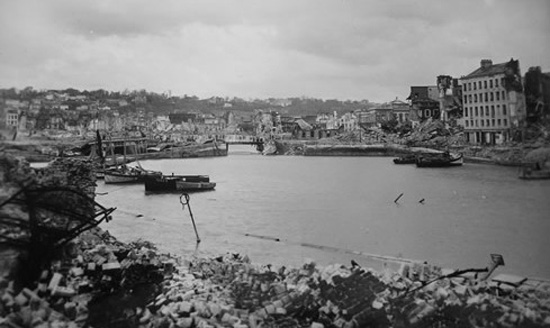
Partial view of Le Havre port area, France, following extensive RAF bombings….
The 12th Hospital Center and the 15th Hospital Center were shipped to the ETO (i.e. the United Kingdom –ed), while the 9th – 10th – 11th – 16th – 17th – 18th – 19th and the 24th Hospitals Centers were quickly inactivated. The 26th – 27th – 28th – 29th – 30th and 31st Hospital Centers were activated for service in the Pacific Theater, followed by the 801st – 802d – 803d – 804th – 805th – 806th, for service in the United Kingdom Base, and the 807th – 808th – 809th – 812th – 813th – 814th – 815th – 818th – 819th – and 820th Hospital Centers, for service on the continent (the 810th – 811th – 816th and the 817th HC were inactivated too –ed).
Activation:
The unit was initially constituted as the 807th Medical Service Detachment on 27 October 1944 in the Army of the United States, as per Activation Order No. 33, Headquarters, ComZ, ETO, and organized under T/O & E 8-500. After having initially been activated in England on 22 November 1944, where it was only to remain for a short period pending its new assignment for duty on the continent, the unit was eventually reorganized and redesignated on 10 April 1945 as Headquarters & Headquarters Detachment, 807th Hospital Center, by authority of Organization Order No. 219, dated 29 March 1945, Headquarters, Communications Zone, European Theater of Operations, United States Army.
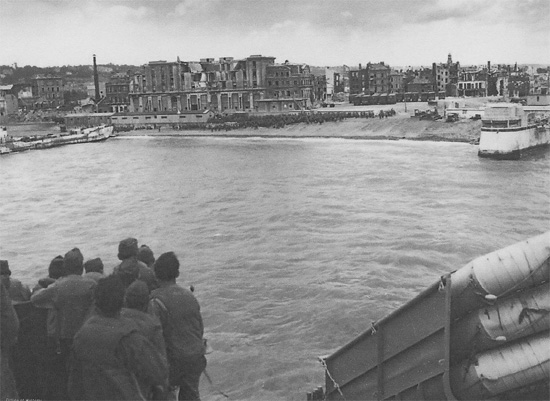
Engineer troops arriving at Le Havre, France. A lot of manpower and heavy equipment were required to prepare and repair the installations for debarkation of reinforcements and supplies (in the beginning goods and supplies were brought ashore via lighters and barges rather than by direct quayside unloading because of the demolitions). Although Le Havre could not rank with Cherbourg in capacity or performance, it did contribute to the war effort, initially as a port of debarkation and later as a port of embarkation for Redeployment of US troops after V-E Day
The 807th Hospital Center was inactivated 27 October 1945 at Camp Sibert, Attalia, Alabama, Zone of Interior (Chemical Warfare Replacement Training Center: total acreage 37,394, troop capacity 1,299 Officers and 22,738 Enlisted Men –ed).
Organization:
The 807th Medical Service Detachment (807th Hospital Center) was activated on 22 November 1944 under command of Captain Harry H. Miller, Jr., MAC, O-1543243, who became responsible for the organization as of 14 January 1945. At the time, the authorized strength of the Hospital Center (General Hospitals not included –ed) only consisted of 7 Officers – 1 Nurse – 1 Warrant Officer – and 23 Enlisted Men.
United Kingdom:
The 807th Med Sv Det was established in the United Kingdom Base, and located at North Mimms Park, Hertfordshire, England. The Enlisted cadre for the unit was assigned on 17 January 1945 and consisted of 23 EM. The organization was initially attached to the 7th General Hospital (affiliated to Boston City Hospital, Boston, Massachusetts, activated 10 June 1943, embarked for England 5 December 1943 –ed) for rations and quarters during the period of 14 January to 29 January 1945. During this 2-week period, Captain H. Miller and his group were organized, completely equipped, and prepared the Detachment for movement to the European continent, where it was to be eventually set up.
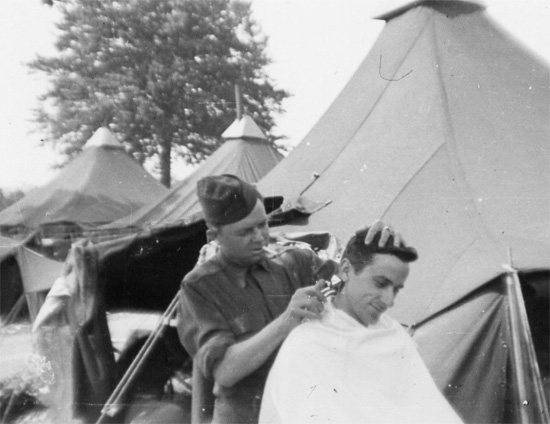
Barber service available at Camp “Twenty Grand”, France. The camp was one of the many “Cigarette” Camps (staging areas for debarking Reinforcements – Replacements for the European Theater, and for embarkation of troops for Redeployment to either the Zone of Interior or the Pacific).
France:
On 30 January 1945, the 807th entrucked for the marshalling area. The unit was divided into a motor party, consisting of 4 Enlisted Men and all the organization’s equipment, and a march party consisting of the CO (Captain Harry H. Miller) and the remaining 19 Enlisted personnel. They reached camp at the marshalling area the same day, preparing for movement across the English Channel. Final destination: Le Havre, France.
On 2 February, the motor party deployed to the continent arriving at Camp “Twenty Grand” (one of the Cigarette camps) on 5 February 1945. The march party only left on 7 February 1945, joining the other group at Camp “Twenty Grand” on 8 February 1945. Crossing by both parties was accomplished without any unusual events.
The following medical units were assigned to the Southern District, Normandy Base Section, and attached to the 807th Hospital Center on 10 February 1945:
38th Station Hospital (400 beds, Ecole Normale pour Garçons, Chartres)
166th General Hospital (1000 beds, site # 4, Le Mans)
170th General Hospital (1000 beds, site # 3, Le Mans)
177th General Hospital (1560 beds, Hospice Civil, Le Mans)
In addition to the above, the 261st – 262d and 263d Medical Service Detachments were also further attached to the 807th HC.
The above listed Hospitals were located in different locations. All the General Hospitals as well as two of the Medical Service Detachments were established in the vicinity of Le Mans, France, while the 38th Station Hospital was set up at Chartres, France. The remaining Medical Service Detachment was located at Alençon, France. All organizations were in operation when attached to the 807th Hospital Center.
Upon arrival, Captain Harry Miller joined the motor party, leaving the First Sergeant in charge of the march party. The first group then departed for its final destination, being, Le Mans, France, where it arrived 12 February 1945. It was joined by the march party which arrived 3 days later.
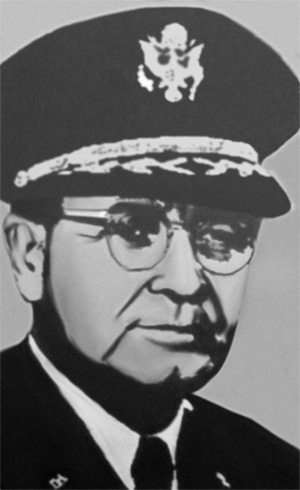
Photograph illustrating Colonel Milford T. Kubin, MC, O-18278, second Commanding Officer, 807th Hospital Center. Colonel M. Kubin took over command from Captain Harry Miller, on 25 March 1945, and remained the unit’s CO until 1 September 1945.
While in the process of being properly organized, 13 Enlisted Men were placed on TD with the 177th General Hospital for a period of 7 days, the date was 22 February 1945. The men included were:
Francis Chabak, Private First Class, 32923432
Robert S. Duskin, Private First Class, 33577986
Freddie D. Eshenower, Corporal, 39258953
Robert E. Henry, Private First Class, 35342053
Paul F. Jones, Private, 38421045
Anthony E. Lauritis, Technician 5th Grade, 36626319
Murray C. Lester, Technician 4th Grade, 12058175
Thomas D. Romanello, Private, 32341730
Richard D. Rulon, Private, 37478515
Milton J. Schuster, Technician 5th Grade, 32780526
Pat P. Tompkins, Private, 34773642
Henry L. Woodard, Private First Class, 38184765
Frankie D. Zeornes, Technician 4th Grade, 37208682
The 807th Medical Service Detachment was eventually assigned to the Southern District, Normandy Base Section, and set up its office in the Headquarters building of the Southern District. While preparing the cadre of the 807th for operation as a proper Hospital Center, Captain Miller was assigned as the Medical Administrative Officer (MAC) to the Southern District Commander and given the additional responsibility of establishing the Southern District Surgeon’s Office. The latter was staffed by personnel of the 807th who performed both missions as well and continued training of the Enlisted Men emphasizing the Hospital Center activities.
On 1 and 2 March 1945, the following Officers were respectively assigned to the 807th: Captain Herman R. Crookshank, SnC, O-475952 (previously with NBS since 8 August 1944, assigned to 812th HC 3 December 1944, and relieved from assignment to the 812th Hospital Center –ed) and First Lieutenant Roger J. Madera, MAC, O-1543825 (previously with NBS since 5 October 1944 –ed, and assigned to 180th GH 7 January 1945).
In order to bolster the organization and make it more effective, the following units were subsequently assigned to the 807th HC on 14 March 1945 (as per Troop Assignment Order No. 19, Normandy Base Section, dated 6 March 1945):
124th Medical Service Detachment (Mess Team)
157th Medical Service Detachment (Service team)
177th Medical Service Detachment (Mechanic Team)
317th Medical Service Detachment (Maintenance Team)
On 14 March 1945, Colonel Milford T. Kubin, MC, O-18278, was attached to the 807th. The Officer was officially assigned to the 807th Hospital Center on 25 March 1945, and assumed command of the organization, thereby replacing Captain Harry H. Miller. The new CO was further assigned the additional duties as the Southern District Surgeon, Normandy Base Section, Communications Zone, European Theater of Operations, APO 562, US Army.
On 27 March 1945, Major Robert C. Fuller, VC, O-314045, was assigned and was followed by First Lieutenant Sidney J. Wagman, MAC, O-1546673, on 28 March 1945.
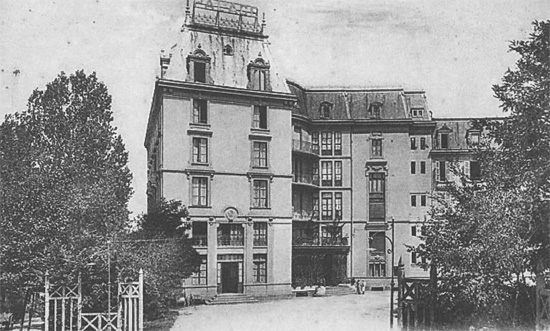
View of the “Palace” Hotel, Vittel, France. Home of the 807th Hospital Center where it was stationed from 16 April 1945 until 18 July 1945.
Early April, the 807th Medical Service Detachment (Hospital Center) was redesignated as Headquarters and Headquarters Detachment, 807th Hospital Center as per Paragraph 1, Organization Order No. 219, Headquarters, European Theater of Operations – US Army (ETOUSA), File AG 322 OP, dated 29 March 1945.
It should be noted that while the medical troop build-up for ETOUSA substantially achieved its objectives in terms of gross numbers of personnel and units, strength totals concealed many shortages and deficiencies (this particularly applied to the 166th and 170th Gen Hosp –ed). In order to place units in the Theater as soon as possible, many of the hospital units were transferred overseas before they had completed their training (this applied to 78 of the 151 General Hospitals called for overseas service –ed). Moreover, some of the organizations had to wait for sites to become available, and for transportation to arrive. After arrival in the temporary staging areas, units frequently became separated from their personal baggage and TAT equipment during their journeys across France. Some even arrived without tentage, bedding, vehicles, and housekeeping sometimes had to rely on salvage and borrowing (in his reports, Captain H. Miller often stated the lack of sufficient transportation for moving patients, there was always a shortage of trucks and ambulances, and also communications were a challenge –ed). It was the role of the Base Sections to keep units busy during staging, by conducting orientation and training programs and sending personnel on TD to reinforce hard-pressed medical units already in operation.
The 166th and 170th General Hospitals were set up in tents and were nevertheless able to increase their bed capacity from 1,000 to 1,500 beds within one week’s time. The 177th General Hospital was housed in buildings and was able to receive station hospital type patients from the vicinity of Le Mans. There were no evacuation problems for these hospitals because of good railway service and loading platforms at Le Mans and Chartres. During the month of April-May 1945, the 166th and 170th General Hospitals evacuated all their American patients and were then redesignated Provisional German Prisoners of War Hospitals and within a period of only seven (7) days they were nearly filled to capacity with German PWs (more US General Hospitals underwent the same reorganization –ed). Due to the large number of Prisoner of War casualties received by the NBS it became advisable to designate certain hospital plants to be used exclusively for this type of patients. Sites # 1, # 2, and # 3 were selected in the Lison area, each having a bed capacity of 1,500; as expansion became necessary, Sites # 1 and # 2 in Carentan were added to the group. These Hospitals were staffed with PW personnel, both professional and administrative (by end of February 1945, protected PW medical personnel were assigned to work in these ‘special’ hospitals; and 65 PW Medical Officers and 572 PW Enlisted Men were at work in these provisional medical installations –ed).
On 15 April 1945, the 807th Hospital Center departed Le Mans, France on a permanent change of station to Vittel, France arriving at its new site the following day. The 807th was then assigned to the Oise Intermediate Section and located its Headquarters at the Vittel Palace Hotel. The Headquarters was established on the first floor of the hotel, the Enlisted Men were billeted on the mezzanine, and the Officers were quartered on the second floor of the hotel. The dayrooms, mess hall, and Officers’ lounge were established on the main floor of the building. A barber shop, tailor shop and utilities shop were also started on the main floor with the respective functions being operated by German PW personnel.
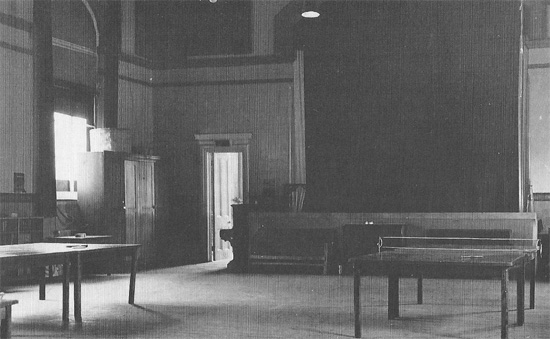
Illustration of one of the dayrooms, providing recreation for both staff and personnel.
On 17 April 1945, the 141st Medical Mess Detachment was attached to the 807th Hospital Center as well as the 21st (served in Algeria, Italy, France –ed), 23d (served in Italy and France –ed), 36th (served in Italy and France –ed), 46th (served in Algeria and France –ed), and the 236th General Hospitals. They were some of the largest Hospitals serving on the European continent and were all affiliated units (all organizations, with the exception of the 236th Gen Hosp had had previous experience in both the Mediterranean and European Theaters, with the 236th already closing for patients on 25 May 1945).
21st General Hospital (affiliated to Washington University, St. Louis, Missouri, activated 12 January 1942)
23d General Hospital (affiliated to Buffalo General Hospital, Buffalo, New York, activated 15 July 1942)
36th General Hospital (affiliated to Wayne University, Detroit, Michigan, activated 28 May 1943)
46th General Hospital (affiliated to University of Oregon, Portland, Oregon, activated 15 July 1942)
The assignment of the additional General Hospitals made the 807th Hospital Center the largest Hospital Center in the Oise Intermediate Section with a total capacity of 15,270 beds.
The 807th Hospital Center had no airstrip to evacuate patients and the receiving and evacuation of all patients was accomplished by Hospital Trains. The distance between the Hospitals was too great to form an ambulance pool, but the 807th HC by controlling the disposition of its patients, was able to secure sufficient ambulances to make any one movement of patients. Patients requiring movement by aircraft were transported by train to Paris (Orly Airport –ed) and then airlifted to the appropriate medical facility in France or the United Kingdom.
The affiliated General Hospitals (21st, 23rd, 36th, and 46th) were so strong professionally that the only organizations to be designated as “specialist” Hospitals were the 46th General Hospital which received all Russian nationals (those cases were eventually transferred to the Russian Military Mission to France for repatriation to Soviet territory, via a military airstrip located near Versailles, France –ed), and the 21st General Hospital which handled all Prisoner of War patients.
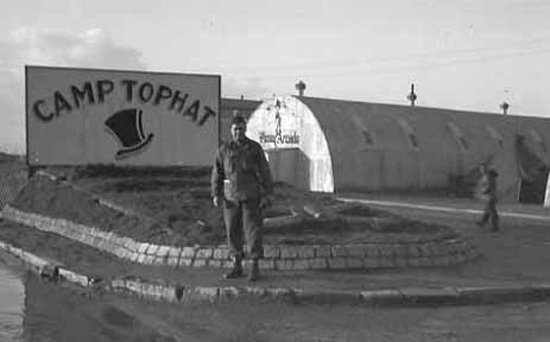
Signpost illustrating Camp “Tophat”, Belgium. This staging area, situated on the left bank of the River Scheldt, Antwerp, Belgium, housed US troops readied for Redeployment to the Zone of Interior.
Officer Staff – 807th Hospital Center, Southern District, Normandy Base Section, ComZ, ETOUSA
(30 March 1945) (incomplete)
Milford T. Kubin, Colonel, MC, O-18278 > Commanding Officer
Derrick T. Vail, Colonel, MC, O-491780
Frank E. Wilson, Lt. Colonel, MC, O-323557
Robert C. Fuller, Major, VC, O-314045 > Veterinary Officer
Jessie M. A. Mutch, Major, ANC, N-741326 > Chief Nurse
Herman R. Crookshank, Captain, SnC, O-475952 > Medical Inspector
Harry H. Miller, Captain, MAC, O-1543243 > Receiving & Evacuation Officer, Plans & Training Officer
Kenneth J. Carlson, First Lieutenant, MC
Roger J. Madera, First Lieutenant, MAC, O-1543825 > Supply & Transportation Officer
Sidney J. Wagman, Captain, MAC, O-1546673 > Adjutant & Personnel Officer, War Bonds Officer
Enlisted Men Roster – 807th Hospital Center (1 September 1945) (incomplete)
Earl C. Anderson, Staff Sergeant, 31173366
Samuel W. Becker, Technician 3d Grade, 12020109 (released from Hq Det, Hq Western District)
Francis Chabak, Private First Class, 32923432
John B. Chavez, Private, 39421096 (released from 106th Gen Hosp)
Oliver J. Cunningham, Corporal, 36183760 (released from 15th Hosp Ctr)
Louis M. D’Amico, Technician 5th Grade, 35283966
George F. DuPonte, Corporal, 31059608
Robert S. Duskin, Private First Class, 33577986
Benner H. Edwards, Technician 4th Grade, 35436983
Freddie D. Eshenower, Corporal, 39258953 (released from 159th Gen Hosp)
Paul J. Fischer, Technician 4th Grade, 32180327 (released from 15th Hosp Ctr)
William D. Frauly, Technician 3d Grade, 17048236 (released from 49th Sta Hosp)
Sidney Goldberg, Technician 4th Grade, 32401386
Nicholas F. Goobie, Master Sergeant, 6906057
Warren A. Hammond, Technical Sergeant, 37254256 (released from 825th Conv Ctr)
Robert E. Henry, Private First Class, 35342053 (released from 83d Gen Hosp)
Leslie S. Hightman, Technical Sergeant, 13001897
Paul F. Jones, Private, 38421045 (released from 159th Gen Hosp)
Anthony E. Lauritis, Technician 5th Grade, 36626319 (released from Hq Det, Hq Eastern District)
Murray C. Lester, Technician 4th Grade, 12058175 (released from Hq Det, Hq Eastern District)
Ralph L. Morrison, Technician 5th Grade, 37409399
Slade A. Norris, Private, 38203092
Frederic Ortiz, Corporal, 39530032
Calvin B. Rogers, Sergeant, 33718532
Thomas D. Romanello, Private, 32341730 (released from 15th Hosp Ctr)
Richard D. Rulon, Private, 37478515 (released from 106th Gen Hosp)
Edwin L. Schmied, Technician 5th Grade, 37407249 (released from Hq Det, Hq Eastern District)
Milton J. Schuster, Technician 5th Grade, 32780526 (released from Hq Det, Hq Western District)
Jacob Speckman, Private First Class, 37156181 (released from 15th Hosp Ctr)
Pat P. Tompkins, Private, 34773642 (released from 106th Gen Hosp)
Joseph Wikenczy, Private, 16149233
Henry L. Woodard, Private First Class, 38184765 (released from 15th Hosp Ctr)
James B. Wynn, First Sergeant, 6979169 (released from 15th Hosp Ctr)
Frankie D. Zeornes, Technician 4th Grade, 37208682 (released from Hq Det, Hq UK Base)
Return to the Zone of Interior:
Following the end of the war in Europe and V-E Day, 8 May 1945, the 807th was primarily engaged in the preparation of units for Redeployment to the Zone of Interior, by reassigning personnel. This effort was effectively started on 1 June and continued on to 11 July 1945.
Prior to its departure from Vittel, France, a unit formation was held for the Enlisted Men who were informed of the provisions of Article of War Number 28 pertaining to unit movement. Following receipt of TWX 8370, emanating from the Commanding General, Oise Intermediate Section, dated 2 July 1945, the personnel were assembled and alerted for overseas movement at 1600 hours, 7 July 1945. Time had come to leave the European Theater.
On 8 July 1945, the 23d and the 36th General Hospitals were released from assignment to the Center and moved to Paris on 12 July. The 21st and 46th General Hospitals followed and were eventually released on 16 July 1945. Another unit to be released was the 141st Medical Mess Detachment which became attached to the 21st General Hospital on 18 July 1945.
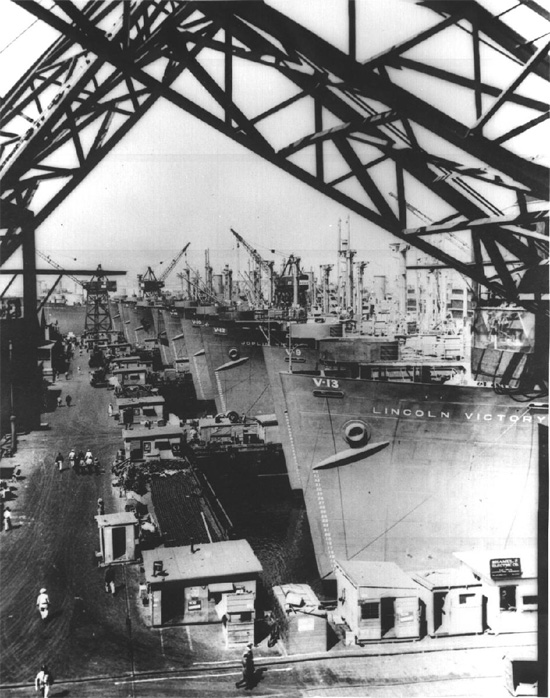
West coast, continental United States. Line up of “Victory” ships. A total of 534 were built in World War Two.
The members of Headquarters & Headquarters Detachment, 807th Hospital Center, in accordance with Movement Orders No. 852, Headquarters, Oise Intermediate Section, dated 11 July 1945, finally departed Vittel, France, by motor convoy, at 1100 hours, 18 July 1945, for Camp “Atlanta”, France (one of the City camps –ed), where they arrived at 1630 hours the same day.After arrival, the unit packed its equipment, marked all crates accordingly, and held appropriate classes to prepare the personnel and staff for the trip home and possible redeployment to the Pacific.
The unit remained at Camp “Atlanta” for staging and eventually departed on 11 August 1945, following Movement Orders, Headquarters, Camp Atlanta, ComZ, USFET, dated 10 August 1945, heading for Camp “Tophat”, near Antwerp, Belgium, where it arrived on 12 August. At Camp “Tophat”, the 807th HC completed final preparation for overseas movement (POM) departing for the Port of Antwerp at 1600 hours, 17 August 1945.
The organization sailed from the Port of Antwerp, Belgium, at 2300 hours, 20 August 1945, aboard the S/S New York University Liberty Ship “Victory” (launched 16 May 1945) with destination the United States.
After a rough crossing of the Atlantic, the S/S NYU “Victory” docked at Pier 13, New York P/E at 1800 hours, 29 August 1945. The personnel debarked at 2000 hours and were transported to Camp Shanks, Orangeburg, New York (Staging Area for New York P/E: total acreage 2,009, troop capacity 2,545 Officers and 46,367 Enlisted Men –ed) where they arrived at 0300 hours, on 30 August 1945.
On 1 September 1945, Lt. Colonel Frank E. Wilson, MC, O-323557, assumed temporary command of the 807th HC until its inactivation. Seven (7) Officers and 19 Enlisted Men departed to join the Separation Centers for their respective discharge from the military service. Following Paragraph # 26, Special Orders No. 231, Army Service Forces, New York Port of Embarkation, Camp Shanks, New York, one Officer and 1 EM departed Camp Shanks by train for Camp Sibert, Attalia, Alabama, where they arrived around 2300 hours, 1 September 1945.
At 2400 hours, 27 October 1945, as authorized by Paragraph 1, General Orders No. 53, Headquarters 1479th Service Command Unit, Camp Sibert, Alabama, dated 25 October 1945, the 807th Hospital Center was officially inactivated.
Commanding Officers – 807th Hospital Center
Harry H. Miller, Jr., Captain > 22 November 1944 – 25 March 1945
Milford T. Kubin, Colonel > 25 March 1945 – 25 September 1945
Frank E. Wilson, Lt. Colonel > 25 September 1945 – 27 October 1945
Campaign Credits – 807th Hospital Center
World War II (EAME streamer w/o inscription)

Historical plaque describing Camp Sibert and its role during World War Two. The camp was a 37,394-acre installation in Northeastern Alabama, initially established for use as a Replacement Training Center for the Chemical Warfare Service. The 807th Hospital Center was inactivated at Camp Sibert 27 October 1945.
Our most sincere thanks go to Ed J. Brown for providing the MRC staff with a lot of data and copies of original documents as well as some photos related to the World War Two history of the 807th Hospital Center. Many documents were based on the unit’s official history written by Captain Harry H. Miller, Jr., MAC, O-1543243, the organization’s first Commanding Officer.
